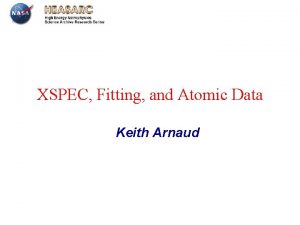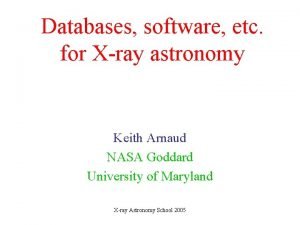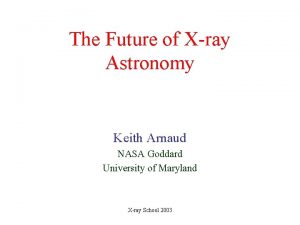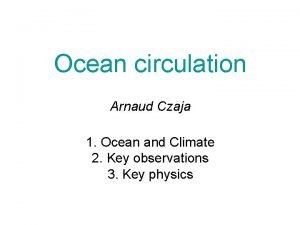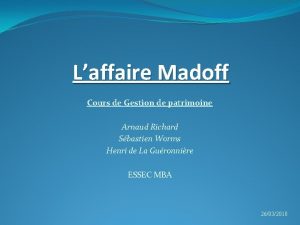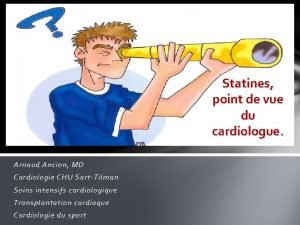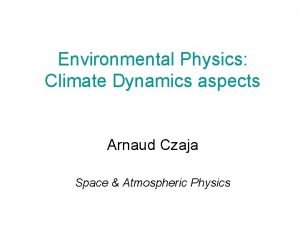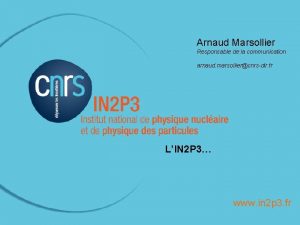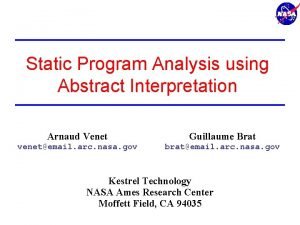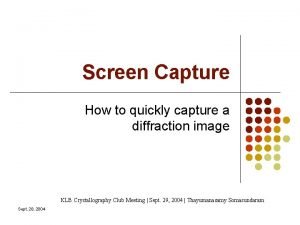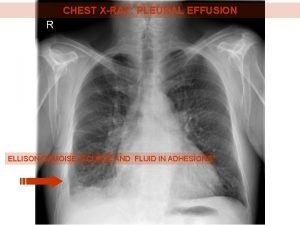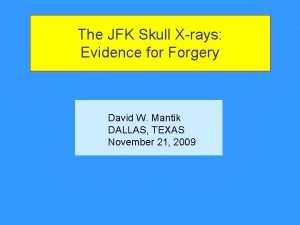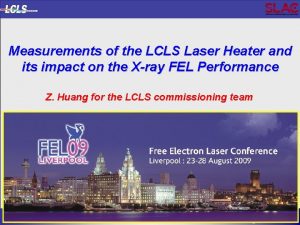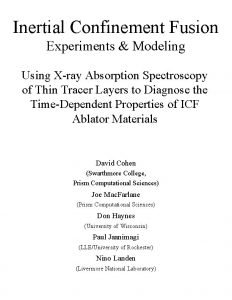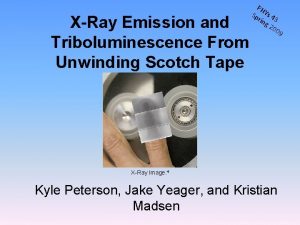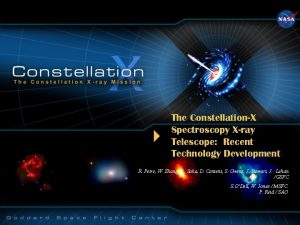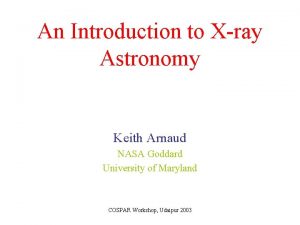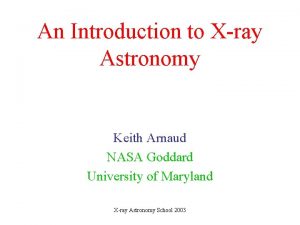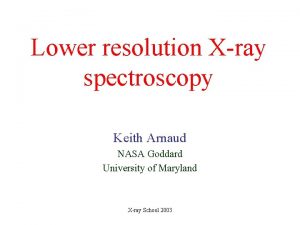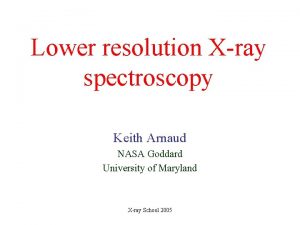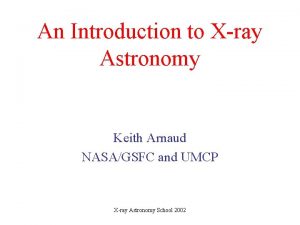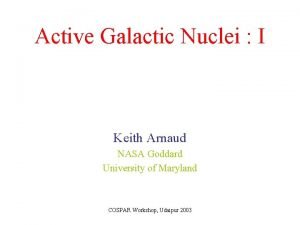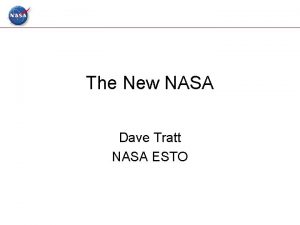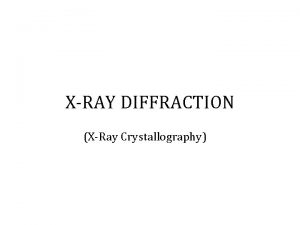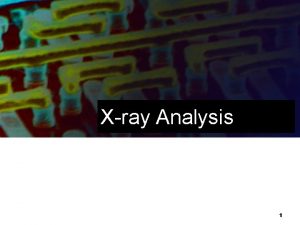The Future of Xray Astronomy Keith Arnaud NASA















































- Slides: 47

The Future of X-ray Astronomy Keith Arnaud NASA Goddard University of Maryland X-ray School 2003

Theme In the first 40 years of X-ray astronomy we increased sensitivity by a factor of 109, image resolution by 2. 5 x 105, spectral resolution by 104, timing resolution by 104. How do we keep this progress up for the next 40 years ? • High sensitivity, high resolution spectroscopy. • Polarimetry • Interferometry X-ray School 2003

• High sensitivity, high resolution spectroscopy. • Polarimetry • Interferometry X-ray School 2003

X-rays on Ice The XRS X-ray microcalorimeter built for Astro-E (the fifth Japanese X-ray astronomy satellite) Resolution : 9 - 12 e. V FWHM (0. 5 - 10 ke. V) X-ray School 2003

Inserting the He dewar in the Ne dewar A solid Ne dewar outside a liquid He dewar outside an adiabatic demagnetization refrigerator. X-ray School 2003

Astro-E Launch - February 2000 X-ray School 2003

20 seconds and going well X-ray School 2003

Uh - oh X-ray School 2003

You really don’t want to see this Astro-E is being rebuilt as Astro-E 2 and will be launched in Feb 2005. Rebuilt calorimeter now has resolution of 6 e. V. X-ray School 2003

Constellation-X X-ray School 2003

Constellation-X Overview o Use X-ray spectroscopy to observe § Black holes: strong gravity & evolution § Large scale structure in the Universe & trace the underlying dark matter § Production and recycling of the elements o Mission parameters § Telescope area: 3 m 2 at 1 ke. V 100 times XMM/Chandra for high res. spectra § Spectral resolving power: 300 -3, 000 5 times improvement at 6 ke. V § Band pass: 0. 25 to 40 ke. V 100 times more sensitive at 40 ke. V X-ray School 2003

X-ray School 2003

X-ray School 2003

X-ray School 2003

XEUS • ESA proposed mission for low Earth orbit. • 6 m 2 of collecting area at 1 ke. V. • Imaging resolution goal of 2" HEW (Half Energy Width) at 1 ke. V. • Limiting sensitivity 100 times deeper than XMM-NEWTON. • Spectral resolution of 1 to 10 e. V between 0. 05 and 30 ke. V. X-ray School 2003

XEUS II • After completion of the initial 4 -6 year mission phase, XEUS will rendezvous with the ISS for refurbishment and adding extra mirror area. • New detector spacecraft with next generation of focal plane technologies. • Grown mirror will have 30 m 2 collecting area at 1 ke. V; 3 m 2 at 8 ke. V. • Sensitivity 250 times better than XMM-NEWTON. X-ray School 2003

Con-x X-ray School 2003

Generation X o Scientific goal: to probe the X-ray emission from the universe at z = 5 -10. o An effective area of 150 m 2 at 1 ke. V with an angular resolution of ~ 0. 1 arc second. o Detect sources 1000 times fainter than Chandra (flux limit of 2 x 10 -20 ergs/cm 2/s). o Obtain high resolution spectra from sources 100 -1000 x fainter than observable by Constellation-X. o Six identical satellites with 40 to 150 m focal length to L 2. X-ray School 2003

Telescope Evolution No. Angu of lar mod HPD s Eff. Area @ 1 ke. V (cm 2 ) per mod. Mass (kg) per mod. Notes Chandra 1 0. 5" 1, 000 Ground and polished glass shells XMM-Newton 3 15" 1, 500 420 Replicated Ni shells Astro-E 5 90" 400 12 Replicated Al segments Constellation-X 4 15" 7, 500 420 Material and technology under study/development Generation-X 6 0. 1" 250, 000 3, 000 Materials and fabrication technology to be determined

• High sensitivity, high resolution spectroscopy. • Polarimetry • Interferometry X-ray School 2003

Why X-ray Polarimetry ? • Because it’s there ! Whenever we look at the Universe in a new way we make unexpected discoveries. • We expect polarization from X-ray synchrotron sources such as SNR and jets. Also from X-ray reflection in binaries and AGN. X-ray School 2003

Polarization mechanisms X-ray School 2003

Examples X-ray School 2003

Testing QED X-ray School 2003

But can we detect X-ray polarization ? • There is one detection of X-ray polarization - that of the Crab Nebula SNR. • No X-ray polarimeter has flown on a satellite since the 1970 s. • There is a new idea for a more efficient polarimeter… X-ray School 2003

Measuring Polarization X-ray School 2003

Electron Tracks X-ray School 2003 Bellazzini et al.

Microwell detector X-ray School 2003 Bellazzini et al.

Bellazzini et al. X-ray School 2003

Accumulation of many events 5. 9 Ke. V unpolarized X-ray School 2003 5. 4 Ke. V polarized Bellazzini et al.

• High sensitivity, high resolution spectroscopy. • Polarimetry • Interferometry X-ray School 2003

X-ray Interferometry • While astronomical sensitivity has increased by a vast factor imaging resolution has not. HST is only 100 times better than Galileo’s telescope. • To do better requires interferometry. • Radio interferometry is well developed but baselines are very long and few sources have high enough surface brightness in the radio band. • Optical interferometry is in the experimental stage and milliarcsec resolutions should be achievable. X-ray School 2003

X-ray Interferometry II The X-ray band is the natural place for interferometry ! • Microarcsecond resolutions are possible with a baseline of ~10 meters. • X-ray sources have very high surface brightness on microarcsecond scales. X-ray interferometry allows virtual interstellar travel… X-ray School 2003

100 milliarcseconds X-ray School 2003

10 milliarcseconds X-ray School 2003

1 milliarcsecond X-ray School 2003

100 microarcseconds X-ray School 2003

10 microarcseconds X-ray School 2003

1 microarcsecond X-ray School 2003

X-ray School 2003

Scientific Goals X-ray School 2003

X-ray School 2003

X-ray School 2003

Laboratory test Fringes at 8. 35 Å 25 November 2002 X-ray School 2003

Test set-up at Goddard X-ray School 2003

MAXIM Pathfinder 1 km Science Phase #1 Low Resolution (100 mas) Launch 200 km Science Phase #2 High Resolution (100 nas) 20, 000 km Transfer Stage X-ray School 2003

Timeline 2004 Swift (US) 2005 Astro-E 2 (Japan-US) 2007 Astrosat (India) 2009? Ne. XT (Japan-? ) 2013? Constellation-X (US) 2015? ? XEUS (ESA), Maxim Pathfinder (US) 2025? ? ? Generation-X (US), Maxim (US) X-ray School 2003
 Keith arnaud
Keith arnaud Keith arnaud
Keith arnaud Keith arnaud
Keith arnaud Learning astronomy by doing astronomy answers
Learning astronomy by doing astronomy answers Learning astronomy by doing astronomy activity 1 answers
Learning astronomy by doing astronomy activity 1 answers Learning astronomy by doing astronomy
Learning astronomy by doing astronomy Future perfect continuous tense example
Future perfect continuous tense example Future perfect e future continuous
Future perfect e future continuous Ngayon kakahigin ngayon tutukain paliwanag
Ngayon kakahigin ngayon tutukain paliwanag Calipso data download
Calipso data download Arnaud giovaninetti causa de la muerte
Arnaud giovaninetti causa de la muerte Arnaud alcabez
Arnaud alcabez Elsa fayer seins
Elsa fayer seins New city college poplar
New city college poplar Arnaud czaja
Arnaud czaja Arnaud czaja
Arnaud czaja Arnaud wilm
Arnaud wilm Docteur arnaud richard
Docteur arnaud richard Arnaud ventura
Arnaud ventura Arnaud gelas
Arnaud gelas Arnaud
Arnaud Arnaud gelas
Arnaud gelas Faurecia eppap
Faurecia eppap Wild berry
Wild berry Arnaud poujardieu
Arnaud poujardieu Arnaud pasquiers
Arnaud pasquiers Quizlet
Quizlet Arnaud courgey
Arnaud courgey Arnaud ancion
Arnaud ancion Arnaud czaja
Arnaud czaja Arnaud czaja
Arnaud czaja Arnaud
Arnaud Arnaud marsollier
Arnaud marsollier Arnaud venet
Arnaud venet Concaténe
Concaténe Prehistoric era
Prehistoric era Yxlon xray
Yxlon xray Gimp xray
Gimp xray In capacitor/condenser discharge mobile units,
In capacitor/condenser discharge mobile units, Mmc xray
Mmc xray Foreshortening and elongation
Foreshortening and elongation Ellis curve on chest x ray
Ellis curve on chest x ray Jfk skull
Jfk skull Xray laser
Xray laser Inertial confinement fusion lasers
Inertial confinement fusion lasers Scotch tape x ray
Scotch tape x ray Xray telescope
Xray telescope Noi poi doi toi
Noi poi doi toi
